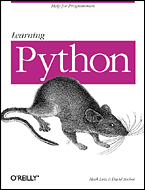Table of Content

Learning Python
Preface
About This Book
Font Conventions
About the Programs in This Book
How to Contact Us
Acknowledgments
I: The Core Language
1. Getting Started
1.1 Why Python?
1.2 How to Run Python Programs
1.3 A First Look at Module Files
1.4 Python Configuration Details
1.5 Summary
1.6 Exercises
2. Types and Operators
2.1 Python Program Structure
2.2 Why Use Built-in Types?
2.3 Numbers
2.4 Strings
2.5 Lists
2.6 Dictionaries
2.7 Tuples
2.8 Files
2.9 General Object Properties
2.10 Built-in Type Gotchas
2.11 Summary
2.12 Exercises
3. Basic Statements
3.1 Assignment
3.2 Expressions
3.3 Print
3.4 if Tests
3.5 while Loops
3.6 for Loops
3.7 Common Coding Gotchas
3.8 Summary
3.9 Exercises
4. Functions
4.1 Why Use Functions?
4.2 Function Basics
4.3 Scope Rules in Functions
4.4 Argument Passing
4.5 Odds and Ends
4.6 Function Gotchas
4.7 Summary
4.8 Exercises
5. Modules
5.1 Why Use Modules?
5.2 Module Basics
5.3 Module Files Are Namespaces
5.4 Import Model
5.5 Reloading Modules
5.6 Odds and Ends
5.7 Module Gotchas
5.8 Summary
5.9 Exercises
6. Classes
6.1 Why Use Classes?
6.2 Class Basics
6.3 Using the Class Statement
6.4 Using Class Methods
6.5 Inheritance Searches Namespace Trees
6.6 Operator Overloading in Classes
6.7 Namespace Rules: The Whole Story
6.8 Designing with Classes
6.9 Odds and Ends
6.10 Class Gotchas
6.11 Summary
6.12 Exercises
7. Exceptions
7.1 Why Use Exceptions?
7.2 Exception Basics
7.3 Exception Idioms
7.4 Exception Catching Modes
7.5 Odds and Ends
7.6 Exception Gotchas
7.7 Summary
7.8 Exercises
II: The Outer Layers
8. Built-in Tools
8.1 Aside: The sys Module
8.2 Built-in Functions
8.3 Library Modules
8.4 Exercises
9. Common Tasks in Python
9.1 Data Structure Manipulations
9.2 Manipulating Files
9.3 Manipulating Programs
9.4 Internet-Related Activities
9.5 Bigger Examples
9.6 Exercises
10. Frameworks and Applications
10.1 An Automated Complaint System
10.2 Interfacing with COM: Cheap Public Relations
10.3 A Tkinter-Based GUI Editor for Managing Form Data
10.4 Design Considerations
10.5 JPython: The Felicitous Union of Python and Java
10.6 Other Frameworks and Applications
10.7 Exercises
III: Appendixes
A. Python Resources
A.1 The Python Language Web Site
A.2 Python Software
A.3 Python Documentation and Books
A.4 Newsgroups, Discussion Groups, and Email Help
A.5 Conferences
A.6 Support Companies, Consultants, Training
A.7 Tim Peters
B. Platform-Specific Topics
B.1 Unix
B.2 Windows-Specific Information
B.3 Macintosh-Specific Information
B.4 Java
B.5 Other Platforms
C. Solutions to Exercises
C.1 Chapter 1
C.2 Chapter 2
C.3 Chapter 3
C.4 Chapter 4
C.5 Chapter 5
C.6 Chapter 6
C.7 Chapter 7
C.8 Chapter 8
C.9 Chapter 9
C.10 Chapter 10
Colophon
EAN: 2147483647
Pages: 156